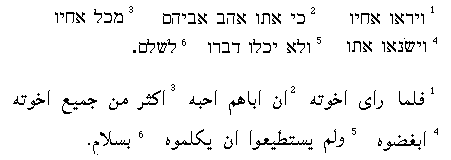When his brothers saw that their father loved him more than any of them,
they hated him and could not speak a kind word to him.

 Study of word order:
Hebrew1 va-iru ahi-v --> and-saw brothers-his
Arabic1 falamma raa ikhwatu-hu --> when saw brothers-his
Hebrew2 khi oto ahab abih-em --> that him loved father-their
Arabic2 anna aba-hum ahabba-hu --> that father-their loved-him
Hebrew3 mikhol eha-v --> than_all brothers-his
Arabic3 akthara min jamii ikhwati-hi --> more than all brothers-his
Hebrew4 va-isneu oto --> and-hated him
Arabic4 abghadu-hu --> hate-him
Hebrew5 ve-lo yakhelu daber-o --> and-not can speak-him
Arabic5 wa-lam yastatiua an yukallimu-hu --> and-not can that speak-him
Hebrew6 re-shalom --> in-peace
Arabic6 bi-salamim --> in-peace
Study of word order:
Hebrew1 va-iru ahi-v --> and-saw brothers-his
Arabic1 falamma raa ikhwatu-hu --> when saw brothers-his
Hebrew2 khi oto ahab abih-em --> that him loved father-their
Arabic2 anna aba-hum ahabba-hu --> that father-their loved-him
Hebrew3 mikhol eha-v --> than_all brothers-his
Arabic3 akthara min jamii ikhwati-hi --> more than all brothers-his
Hebrew4 va-isneu oto --> and-hated him
Arabic4 abghadu-hu --> hate-him
Hebrew5 ve-lo yakhelu daber-o --> and-not can speak-him
Arabic5 wa-lam yastatiua an yukallimu-hu --> and-not can that speak-him
Hebrew6 re-shalom --> in-peace
Arabic6 bi-salamim --> in-peace
 Study of the root of verb:
Hebrew1 the root of "see" is
Study of the root of verb:
Hebrew1 the root of "see" is 

 (H-A-R)
Arabic1 the root of "see" is
(H-A-R)
Arabic1 the root of "see" is 

 (yi-A-R), almost the same
Hebrew2 the root of "love" is
(yi-A-R), almost the same
Hebrew2 the root of "love" is 

 (B-H-A)
Arabic2 the root of "love" is
(B-H-A)
Arabic2 the root of "love" is 

 (B-he-A), almost the same
Hebrew4 the root of "hate" is
(B-he-A), almost the same
Hebrew4 the root of "hate" is 

 (A-N-S)
Arabic4 the root of "hate" is
(A-N-S)
Arabic4 the root of "hate" is 

 (dd-gh-B)
Hebrew5 the root of "speak" is
(dd-gh-B)
Hebrew5 the root of "speak" is 

 (R-B-D)
Arabic5 the root of "speak" is
(R-B-D)
Arabic5 the root of "speak" is 

 (M-L-K)
(M-L-K)
 Summary:
The construction of this text is almost the same, but in detail,
Arabic1,2,3 and 5 are not the same as Hebrew1,2,3 and 5.
This text has 4 Verbs, and 2 of the 4 roots are the same.
Summary:
The construction of this text is almost the same, but in detail,
Arabic1,2,3 and 5 are not the same as Hebrew1,2,3 and 5.
This text has 4 Verbs, and 2 of the 4 roots are the same.

 Study of word order:
Hebrew1 va-iru ahi-v --> and-saw brothers-his
Arabic1 falamma raa ikhwatu-hu --> when saw brothers-his
Hebrew2 khi oto ahab abih-em --> that him loved father-their
Arabic2 anna aba-hum ahabba-hu --> that father-their loved-him
Hebrew3 mikhol eha-v --> than_all brothers-his
Arabic3 akthara min jamii ikhwati-hi --> more than all brothers-his
Hebrew4 va-isneu oto --> and-hated him
Arabic4 abghadu-hu --> hate-him
Hebrew5 ve-lo yakhelu daber-o --> and-not can speak-him
Arabic5 wa-lam yastatiua an yukallimu-hu --> and-not can that speak-him
Hebrew6 re-shalom --> in-peace
Arabic6 bi-salamim --> in-peace
Study of word order:
Hebrew1 va-iru ahi-v --> and-saw brothers-his
Arabic1 falamma raa ikhwatu-hu --> when saw brothers-his
Hebrew2 khi oto ahab abih-em --> that him loved father-their
Arabic2 anna aba-hum ahabba-hu --> that father-their loved-him
Hebrew3 mikhol eha-v --> than_all brothers-his
Arabic3 akthara min jamii ikhwati-hi --> more than all brothers-his
Hebrew4 va-isneu oto --> and-hated him
Arabic4 abghadu-hu --> hate-him
Hebrew5 ve-lo yakhelu daber-o --> and-not can speak-him
Arabic5 wa-lam yastatiua an yukallimu-hu --> and-not can that speak-him
Hebrew6 re-shalom --> in-peace
Arabic6 bi-salamim --> in-peace
 Study of the root of verb:
Hebrew1 the root of "see" is
Study of the root of verb:
Hebrew1 the root of "see" is 

 (H-A-R)
Arabic1 the root of "see" is
(H-A-R)
Arabic1 the root of "see" is 

 (yi-A-R), almost the same
Hebrew2 the root of "love" is
(yi-A-R), almost the same
Hebrew2 the root of "love" is 

 (B-H-A)
Arabic2 the root of "love" is
(B-H-A)
Arabic2 the root of "love" is 

 (B-he-A), almost the same
Hebrew4 the root of "hate" is
(B-he-A), almost the same
Hebrew4 the root of "hate" is 

 (A-N-S)
Arabic4 the root of "hate" is
(A-N-S)
Arabic4 the root of "hate" is 

 (dd-gh-B)
Hebrew5 the root of "speak" is
(dd-gh-B)
Hebrew5 the root of "speak" is 

 (R-B-D)
Arabic5 the root of "speak" is
(R-B-D)
Arabic5 the root of "speak" is 

 (M-L-K)
(M-L-K)
 Summary:
The construction of this text is almost the same, but in detail,
Arabic1,2,3 and 5 are not the same as Hebrew1,2,3 and 5.
This text has 4 Verbs, and 2 of the 4 roots are the same.
Summary:
The construction of this text is almost the same, but in detail,
Arabic1,2,3 and 5 are not the same as Hebrew1,2,3 and 5.
This text has 4 Verbs, and 2 of the 4 roots are the same.
 back to top of TEXT2
back to top of TEXT2